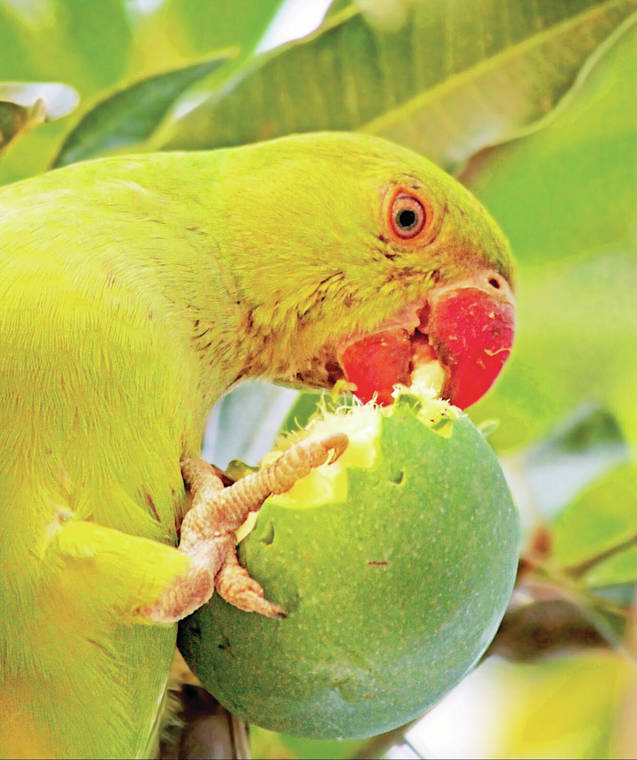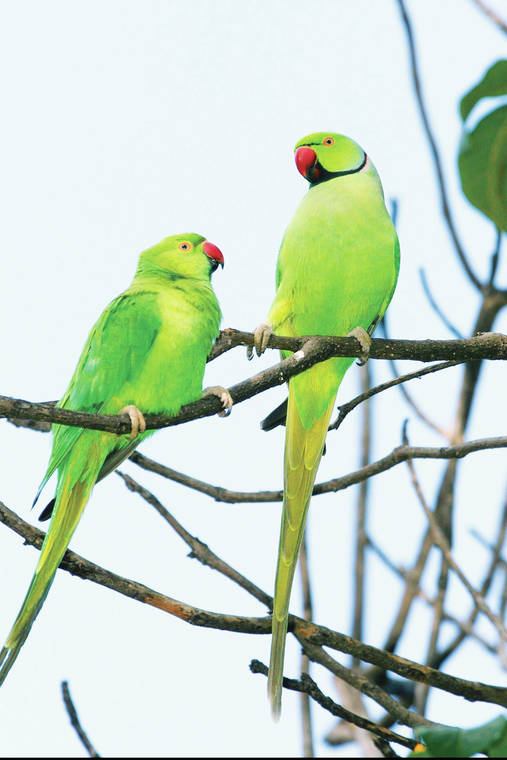KEKAHA — Researchers have documented a decrease in one of the most invasive avian species worldwide on Kaua‘i.
Since the 1960s, rose-ringed parakeets have been documented on island.
“My team estimated a minimum of 10,500 parakeets on Kaua‘i in 2020,” said Dr. Jane Anderson, assistant professor of Research at Caesar Kleberg Wildlife Research Institute of Texas A&M University – Kingsville. “There were extensive efforts to remove parakeets last year. In 2021, my team has estimated a minimum of 7,300 parakeets on Kaua‘i.”
The current population of parakeets is believed to be the decedents of pets that were released in the 1960s, Anderson said.
On Kaua‘i, the parakeets are known to cause damage to crops because they come in groups of 50 to 100 at a time.
“This is impacting the large cornfields as well as local fruit farms and backyard growers,” Anderson said. “Many fruits are impacted such as lychee, citrus, mango, longan, papaya, etc.”
Large gatherings of parakeets, called roosts, sleep together at night causing loud noise, odor and droppings that attract rodents, according to Anderson.
Rose-ringed parakeets are known to be aggressive to native species.
“There are many documented reports of rose-ringed parakeets maiming or killing native species when competing for resources,” Anderson said.
Anderson said that while parakeets are intelligent animals, it is very difficult to keep them from destroying crops.
Some farmers have had luck using netting, but it is expensive and time-consuming to implement. Property owners can request a permit from the state’s Department of Land and Natural Resources, Division of Forestry and Wildlife to cull parakeets on their own property or hire a private wildlife control company.
Tiffani Keanini, manager of Kaua‘i Invasive Species Committee, said farmers, growers and concerned businesses can refer to the group’s “Damage Management Options for Invasive Rose-Ringed Parakeets.” This resource lists various deterrent and control options to help reduce property and agricultural damage caused by rose-ringed parakeets.
Mango farmer Wally Johnson of Kekaha said he first saw the parakeets six to seven years ago and some of his guys have shotguns to scare them away.
“We’ve seen just a little bit of damage but not much,” Johnson said. “We got some guys that they’re watching for them.”
Although Johnson’s farm is luckier than most, he said other farmers have to spend more to protect their crops.
“Like the corn guys, they net everything now,” Johnson said. “That’s a big expense if you put nets over. They’ll really damage those fields — you can get like 60 to 70% damage if you didn’t add them nets.”
Since 2016, a multi-agency collaborative partnership of federal, state, county and private partners has been working on creating a long-term strategy to suppress the population of the invasive bird on Kaua‘i called the Kauai Rose-ringed Parakeet Working Group.
In 2019, phase one of the project was completed by reviewing possible methods and creating a guide for local stakeholders to protect their resources. Currently, the KRRPWG is focusing on research through management, according to Keanini, which includes research to update habitat use and dispersal patterns throughout the island and evaluate potential methods for systematic control with innovative partnerships. This provides necessary data for the subsequent development of the comprehensive, long-term, island-wide population reduction plan in late 2021.
Keanini said KISC has recently launched an outreach campaign calling for community involvement in reporting possible roosts around Kaua‘i. The long-term, island-wide population suppression plan cannot be complete without the community’s help identifying small unknown roosts around the island.
When it comes to reporting the birds, Anderson said at this point her team does not need reports of individual parakeets, however, there is something the community can do.
“We know they have a large distribution across the island during the day,” Anderson said. “Rather, we are hoping the public will report sightings of parakeet roosts, the large congregations of parakeets sleeping together at night. If folks observe parakeets roosting together at night, we ask that they report it.”




I use to think these birds were so pretty to look at.
Till I saw how big the flocks can get.
And the damage they do to mango and lychee trees.
Not so cute anymore.
Wow and they sell for upwards of 1500 to 2,000 here in the states as pets. Perhaps these Farmers need to bird farm instead of cull them.
This article does not list any contact information for reporting a roost. There is a very large roost near my house, at Ka Lae Kiki on Lawai Rd. Every evening, thousands of the parakeets return to it from the direction of the Allerton gardens.
821-1490
Last year while there were no tourists on the island or at our condo I killed a little over 450 of them over about a 6 week period using a pellet rifle with a scope. Since then I’ve only seen about 3. We used to have several hundred land each night in the coconut palms. They were destroying the trees, making ridiculous amounts of noise, and drawing rats and bugs that we’d never seen before. I don’t miss them.
there’s a roost of about 500 of them in the Hanapepe Valley off of Ko Road, near the bend in the river. They fly northeast over Eleele every morning, and return every evening. I’ve watched them land in mango trees in the Eleele Nani subdivision and literally strip them of fruit in a single day.
How are they killing the birds? Hopefully they are not using poison that may be killing other birds, insects, and plants. I heard you can water down a tree at night when they roost and they will not be able to fly and could be captured and moved off the island.
Palani:
Kauai Invasive Species Committee
Office: (808) 821-1490
E-mail: kisc@hawaii.edu
https://www.kauaiisc.org/
Rev. Enge says Catch and Release them over China…The big payback…!